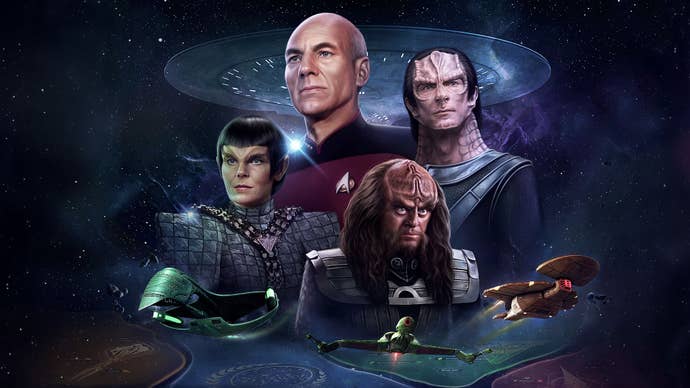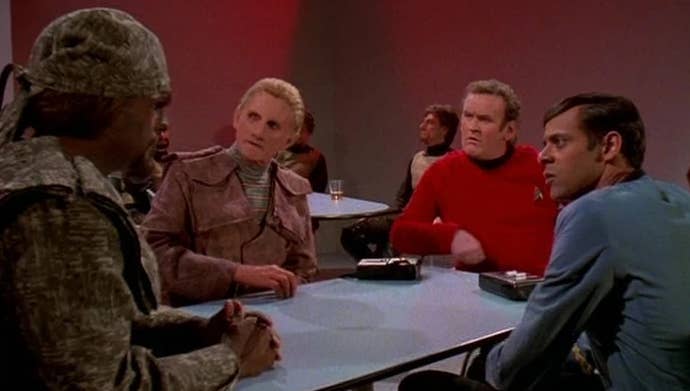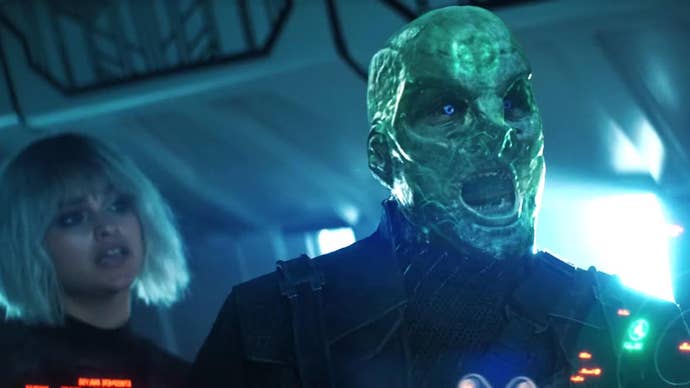Star Trek: Discovery goes out as it came in: robbing better shows of their mystique
Disco’s final season goes boldly where nobody asked, but remains a success story that has defied every critic
Warning: spoilers up to Discovery S05E07 within.
Cards on the table: I’ll watch anything if it has Star Trek in the title. Hell, I’ll happily watch Enterprise, which infamously ditched the franchise branding for its first two seasons in an ill-advised attempt to modernise. It was a bit pants – an ill-fitting prequel series where the ship seemed way more advanced than Kirk’s and had a captain unfit to lick his boots, in the shape of Quantum Leap's nice boy Scott Bakula. At the time, we all thought Star Trek could scarcely get any worse. Oh boy.
Star Trek, much like its hyperactive younger sibling Star Wars, has succumbed to a fate that befalls many legacy IPs in that those in charge of it are so terrified of alienating its existing audience that they rarely, if ever, invent new stuff. And so every new addition to the canon becomes an exercise in navel-gazing: where Star Trek used to be about exploring strange new worlds, it is now mostly about Star Trek. Star Wars is less about the star war than it is about the same twelve lads kicking sand on Tatooine. New Ghostbusters is an expensive eulogy for Old Ghostbusters. Even Doctor Who has favourite versions of himself. The list goes on.
And look, I enjoy all of those things. I’m not smart or discerning enough to be above something that trades on nostalgia, far from it. My absolute favourite of the new Trek shows is Lower Decks, which is essentially an extended love letter to the “Berman era” Trek I grew up with. It noodles around in that world, picking up long discarded threads while machine-gunning jokes at an audience of which it assumes a great deal of prior knowledge.

Discovery is no less afflicted with the franchise’s baggage and no less keen to roll around in it. But it is a frustrating beast. There is a good show in there trying to get out from under all the wet-eyed staring, the cloying overtures, and the tedium of season-long arcs that stretch single-episode ideas over a dozen torturous hours of drip-fed algorithm fodder. In fact, this season, the last ever, has been the best yet for minimising all that.
In previous years Discovery has oscillated between irritating and boredom-inducing with its erratic pacing and unfixable character issues – which require several more articles than I want to write to properly discuss, but it can be summed up as Michael Burnham having several dozen more likeable characters around who are rarely given anything to do beyond looking impressed with her antics. But Season 5 kicks off with a rare treat: a full reveal of what all the fuss is about before the first set of credits roll.
In a small way, it’s a shame that it’s the final season, because this shows real growth. We know very early on, thanks to a diegetic PowerPoint presentation made up of Star Trek: The Next Generation stills (however that’s supposed to work), that this season is all about the Progenitors. That is, a race of latex-smooth humanoids who had a vast Milky Way-spanning empire in the dim and distant aeons before the Federation existed, who were once revealed to have seeded the genesis of all of Star Trek’s various bipedal humanoid races. This happened in an episode of The Next Generation called The Chase which aired around thirty years ago and wasn’t intended to be some sort of earth-shattering revelation for the audience: if anything, it was a bit of a joke. A subtle, version of the sort of jibes Lower Decks regularly makes. A little nudge and/or wink to a savvy audience acknowledging that all the aliens are just regular humans with rubber glued to their heads.

In those days, it wasn’t deemed necessary to explain every imaginable quirk and facet of a fictional universe. Particularly not if that real-world answer boiled down to time and budget, as these things invariably do. Star Trek could have happily continued without ever having answered the question of how a Vulcan and a Human can produce viable offspring. It never needed to explain why Bolians, Andorians, Romulans, Bajorans, Cardassians, and Trills all have the same number of knees and nostrils. It certainly didn’t need to explain why Motion Picture-era Klingons had Cornish pasties for foreheads, while in the original series, they were just dudes covered in Ronseal – and pointedly refused to, even during an episode of Deep Space Nine where both eras of Klingon ended up side-by-side in a Space Welcome Break for reasons I won’t get into.
Years later, Enterprise would spend two precious hours of its jam-packed final season coming up with a stupid explanation for the Klingon discrepancy that was as unnecessary as it was self-indulgent, invoking Khan Noonien-Singh and Data along the way for good measure. Because by that point, the rot had set in. Everything had a prequel. Everything had an origin story. We were at the start of a trend in media that would end with us here, three or four Borg Queens later, where we have an entire TV show explaining how Boba Fett survived the Sarlacc pit (was it even necessary for him to survive?) as a spin-off from the show that explains his hat.
So now, years on from explaining why Mirror Universe ships have moodier lighting, giving Section 31 its own fleet when it’s not even supposed to have a single-ring binder, and walking back its own attempt at a Klingon redesign with lore additions that frankly make no sense, Discovery is back to solve the mystery of the Progenitors - except first, it has to gaslight us into accepting that there is a mystery to solve.

TNG’s episodic nature rarely left anything unresolved after an hour. The Chase’s conclusion is no different. The Progenitors are revealed to be, well, the Progenitors. Asked and answered. Directed panspermia has been a popular theory about the origins of life on Earth since the mid-sixties. The idea that this planet was “seeded” with the genetic code to humanity as a vanity project by some other humanoid species is just one of many science-not-necessarily-fiction concepts, proposed by legitimate scientists and philosophers, that have been folded into Star Trek’s lore. Wormholes. Antimatter. Androids that have working willies. At the time of broadcast, the existence of an ancestor race was no more or less special than a Dyson’s Sphere, or a space probe full of cryogenically frozen capitalists, or any other single-episode idea.
There was no follow-up intended, nor was it deemed necessary to reveal the means by which the Progenitors achieved their galactic seeding project – Discovery’s now fabled “Progenitor Technology” – into a specific thing. It was a time of 22-26 episode seasons, furious competition for ad spend, and nothing in the way of catch-up or on-demand TV service.
Things change, of course. The Chase is now merely Part One of a multi-episode arc of streaming TV, one in which the Progenitor’s tech has been retconned as a thing you can wield like a weapon, as opposed to the vast multi-discipline engineering project you might have imagined it being. Panspermia, more often than not, proposes asteroid impact as a delivery mechanism, so it’s not hard to imagine how that specific bit could be used as a Big Gun. But people with warp drive and transporter technology hardly need a wise ancestor race to explain “hit with big rock”, so one assumes that when this Progenitor Tech is eventually revealed, it’ll be some sort of abstract swirly thing that magics planets to death. Or life. Sort of like the Genesis Device, which is a thing that the Federation already has. We’ll find out in a few weeks, I suppose. Call me cynical, but I’m bracing myself for underwhelment.

It seems vapid to take something merely reflective of a writer’s Clinton-era optimism, and reverence for the likes of Carl Sagan, and turn it into a militarised MacGuffin. Another tedious mystery box for a show that is obsessed with them. But, you could reasonably argue that the Progenitors are fertile ground for fleshing out, and that the producers of Discovery are well within their rights to expand and play around with this mythology. It’s not like there was ever a specific intent to never refer back to it. It would probably have been far more interesting to examine its effect at a societal level, a diplomatic level, a religious level – but Disco has a quota of cool flips to fill, and Star Trek being a patient show about competent people having meetings is a thing of the past. So, if one squints, it’s not hard to see why this show is the way it is.
No amount of squinting can clear up the horrendous decision to ruin The Breen, however. It has stripped away the mystique of a Star Trek race whose entire USP was mystique. From scant mentions on Next Generation to their emergence in Deep Space Nine as a major Alpha Quadrant power of never-nudes, canonical information about them is deliberately scarce, vague, and contradictory. What little we were led to understand about the Breen homeworld, for example – that it is frozen – was contradicted on-screen by fan-favourite Dominion schemer Weyoun, describing the planet as “quite temperate”. Was he telling the truth? Who knows. If that’s the case, why does the Breen need refrigeration suits? What do they look like under their helmets? Are they androids? Are they all Carrie Fisher? Beats us, but have fun discussing it on TrekBBS!
But now we have answers to those questions. Answers so contorted around these contradictions that they barely make sense. Refrigeration as a form of healing therapy? The Breen are gelatinous unless they choose not to be, which they have a huge cultural stigma against? Their mysterious language being an electronic distortion of sounds they apparently make with normal humanoid throats? Nothing that Discovery could have imagined to fill in these gaps would ever have stood up to decades of fan speculation, but it’s gobsmackingly poor form to make them normal Star Trek guys.

Unmasking The Breen demonstrates, for what must be the dozenth time, that the makers of Discovery have been let loose on something that they barely understand the appeal of. And it’s still frustrating because there are glimmers of a much better show midst all of this.
The previous season finale dealt with Star Trek’s most alien race yet – aliens from the edge of the galaxy whose language was so incomprehensible that actual problem-solving had to be done by the crew to decipher it. It was probably the most realistic depiction of what a real first-contact situation would be like. Let’s not forget that Discovery gave us the backdoor pilot for Strange New Worlds, which is an almost flawless Star Trek show for the modern age that simply wouldn’t have been possible without Discovery’s breakout success in reviving the franchise altogether.
This season has had some barnstorming action scenes, episodic adventures, and the addition of a great new character in the form of Commander Rayner who adds some much-needed conflict to the obscenely schmaltzy bridge dynamic. It also had one of those episodes where they go down to a primitive planet and end up getting caught up in a seemingly harmless ceremony that turns out to be a sinister human sacrifice ritual. That’s proper Star Trek, that is. They even disguised themselves by changing into rags and drawing some crap on their foreheads. Bliss. The nineties are back, baybee.

We’ve still got three episodes to go, so it’s not over quite yet. But while I will stick with it until the end because it’s Star Trek and I’m a mark, I won’t miss it when it’s gone – I have a love/hate relationship with Discovery that leans a bit heavily toward the latter end. It’s often tedious, the art direction is edgier than a teenager’s bedroom wall, it’s full of bland characters, and some of the retcons and lore additions it has made have been absolutely atrocious. Vile. Bordering on cultural vandalism.
And yet, it defied the ranty YouTube critics who forecast its cancellation within one season. Then two. Then three. Then four. Some of those people will be gloating now as the show comes to an extraordinarily successful run for an expensive science fiction show in the streaming era, but only to make way for its second of three spin-offs: a Starfleet Academy-focused show which I’ve no doubt will be essentially Discovery Season 6 in practice. And I have to credit it with bringing back my beloved Star Trek for a round of new triumphs: a definitive ending for the TNG crew, Lower Decks, Prodigy, and the aforementioned Strange New Worlds have all been entirely worth investing in.
Yes, it’s a bit crap. But what a legacy it leaves behind. In that way, it may be the most Star Trek show of all.

